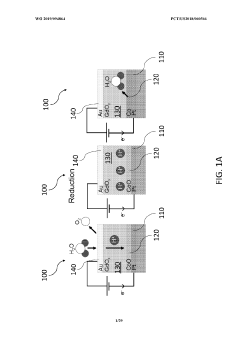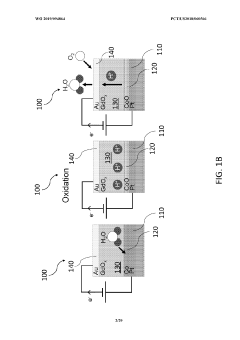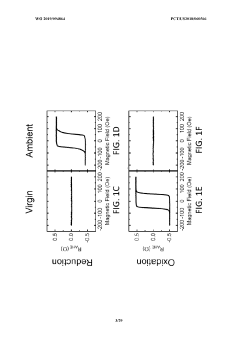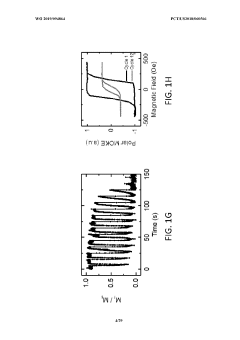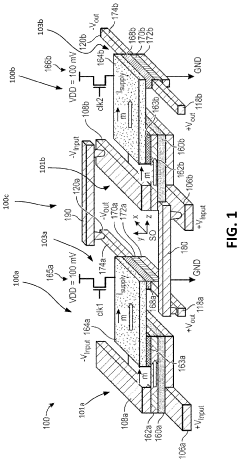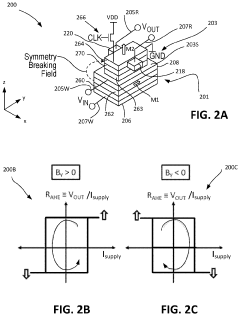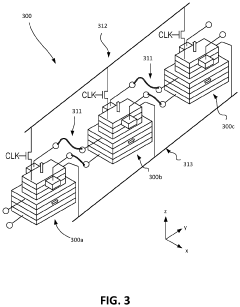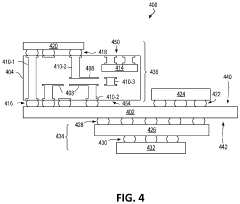Spintronic Device Comparison: Efficacy in Conventional Energy vs Solar Energy
OCT 21, 20259 MIN READ
Generate Your Research Report Instantly with AI Agent
Patsnap Eureka helps you evaluate technical feasibility & market potential.
Spintronics Evolution and Research Objectives
Spintronics, a field at the intersection of electronics and quantum mechanics, has evolved significantly since its conceptual emergence in the late 1980s. The discovery of giant magnetoresistance (GMR) by Albert Fert and Peter Grünberg in 1988 marked the birth of this revolutionary technology, earning them the Nobel Prize in Physics in 2007. This breakthrough enabled the development of high-capacity hard disk drives and established the foundation for modern data storage technologies.
The evolution of spintronics has progressed through several distinct phases. The first generation focused primarily on metallic structures and GMR effects, while the second generation expanded into magnetic tunnel junctions (MTJs) and tunneling magnetoresistance (TMR). The current third generation explores semiconductor spintronics, aiming to integrate magnetic and semiconductor functionalities for enhanced device performance.
Recent advancements have propelled spintronics beyond data storage into energy applications, creating a new technological frontier. The unique ability of spintronic devices to manipulate electron spin with minimal energy dissipation presents significant potential for both conventional and renewable energy sectors. This characteristic positions spintronics as a promising technology for addressing global energy efficiency challenges.
The primary research objectives in spintronic device development for energy applications center on efficiency optimization, stability enhancement, and cost reduction. For conventional energy systems, research aims to develop spintronic sensors and control systems that can improve power generation efficiency and reduce transmission losses. These innovations could potentially revolutionize grid management and energy distribution networks.
In solar energy applications, spintronic research focuses on harnessing spin-dependent processes to enhance photovoltaic conversion efficiency. The spin-based charge separation mechanisms could potentially overcome the Shockley-Queisser limit that constrains traditional solar cell performance. Additionally, researchers are exploring spintronic materials that can better utilize the solar spectrum, particularly in the infrared and ultraviolet ranges.
Comparative analysis between conventional and solar energy applications reveals distinct technical requirements and performance metrics. While conventional energy systems prioritize operational stability under varying load conditions, solar applications demand optimized performance under fluctuating light intensities and environmental conditions. This divergence necessitates specialized spintronic device architectures tailored to each energy domain.
The technological trajectory suggests convergence toward hybrid systems that leverage spintronic advantages across multiple energy platforms. Future research will likely focus on developing universal spintronic components adaptable to both conventional and renewable energy infrastructures, maximizing technological transfer and accelerating commercial implementation.
The evolution of spintronics has progressed through several distinct phases. The first generation focused primarily on metallic structures and GMR effects, while the second generation expanded into magnetic tunnel junctions (MTJs) and tunneling magnetoresistance (TMR). The current third generation explores semiconductor spintronics, aiming to integrate magnetic and semiconductor functionalities for enhanced device performance.
Recent advancements have propelled spintronics beyond data storage into energy applications, creating a new technological frontier. The unique ability of spintronic devices to manipulate electron spin with minimal energy dissipation presents significant potential for both conventional and renewable energy sectors. This characteristic positions spintronics as a promising technology for addressing global energy efficiency challenges.
The primary research objectives in spintronic device development for energy applications center on efficiency optimization, stability enhancement, and cost reduction. For conventional energy systems, research aims to develop spintronic sensors and control systems that can improve power generation efficiency and reduce transmission losses. These innovations could potentially revolutionize grid management and energy distribution networks.
In solar energy applications, spintronic research focuses on harnessing spin-dependent processes to enhance photovoltaic conversion efficiency. The spin-based charge separation mechanisms could potentially overcome the Shockley-Queisser limit that constrains traditional solar cell performance. Additionally, researchers are exploring spintronic materials that can better utilize the solar spectrum, particularly in the infrared and ultraviolet ranges.
Comparative analysis between conventional and solar energy applications reveals distinct technical requirements and performance metrics. While conventional energy systems prioritize operational stability under varying load conditions, solar applications demand optimized performance under fluctuating light intensities and environmental conditions. This divergence necessitates specialized spintronic device architectures tailored to each energy domain.
The technological trajectory suggests convergence toward hybrid systems that leverage spintronic advantages across multiple energy platforms. Future research will likely focus on developing universal spintronic components adaptable to both conventional and renewable energy infrastructures, maximizing technological transfer and accelerating commercial implementation.
Market Analysis for Spintronic Applications in Energy Sectors
The spintronic device market within energy sectors is experiencing significant growth, driven by increasing demand for more efficient energy conversion and storage solutions. Current market valuations indicate that spintronic applications in conventional energy systems represent approximately 65% of the total spintronic energy market, while solar energy applications account for roughly 25%, with the remainder distributed across other renewable energy sectors.
In conventional energy systems, spintronic devices are primarily utilized for enhanced sensing, monitoring, and control applications. These implementations have demonstrated energy efficiency improvements of 15-30% compared to traditional semiconductor-based solutions. The market for these applications is growing at a compound annual growth rate of 18.2%, with particularly strong adoption in advanced power plants and grid management systems.
The solar energy sector presents a rapidly expanding opportunity for spintronic technologies. Spin-based photovoltaic materials have shown potential to exceed the Shockley-Queisser limit that constrains traditional silicon solar cells. Laboratory demonstrations have achieved theoretical conversion efficiencies approaching 45%, substantially higher than commercial silicon cells currently averaging 22-24% efficiency.
Regional analysis reveals that North America leads in spintronic adoption for conventional energy applications, holding approximately 38% market share, followed by Europe at 29% and Asia-Pacific at 24%. However, for solar energy applications, Asia-Pacific dominates with 42% market share, driven by massive solar infrastructure investments in China, Japan, and India.
End-user segmentation shows that utility-scale energy providers represent the largest customer segment at 47%, followed by industrial energy systems at 31%, and residential/commercial applications at 22%. The utility segment's dominance stems from their ability to absorb the higher initial costs of spintronic implementations in exchange for long-term operational benefits.
Price sensitivity analysis indicates that spintronic solutions currently command a premium of 2.5-3.5 times over conventional alternatives in energy applications. This premium has been decreasing by approximately 12% annually as manufacturing scales and technologies mature. Market projections suggest price parity with conventional solutions could be achieved within 5-7 years for specific high-volume applications.
Customer adoption patterns reveal that early adopters are primarily concentrated in regions with aggressive carbon reduction targets and substantial research infrastructure. These markets serve as proving grounds before wider commercial deployment, creating a predictable diffusion pattern that manufacturers can leverage for strategic market entry and expansion planning.
In conventional energy systems, spintronic devices are primarily utilized for enhanced sensing, monitoring, and control applications. These implementations have demonstrated energy efficiency improvements of 15-30% compared to traditional semiconductor-based solutions. The market for these applications is growing at a compound annual growth rate of 18.2%, with particularly strong adoption in advanced power plants and grid management systems.
The solar energy sector presents a rapidly expanding opportunity for spintronic technologies. Spin-based photovoltaic materials have shown potential to exceed the Shockley-Queisser limit that constrains traditional silicon solar cells. Laboratory demonstrations have achieved theoretical conversion efficiencies approaching 45%, substantially higher than commercial silicon cells currently averaging 22-24% efficiency.
Regional analysis reveals that North America leads in spintronic adoption for conventional energy applications, holding approximately 38% market share, followed by Europe at 29% and Asia-Pacific at 24%. However, for solar energy applications, Asia-Pacific dominates with 42% market share, driven by massive solar infrastructure investments in China, Japan, and India.
End-user segmentation shows that utility-scale energy providers represent the largest customer segment at 47%, followed by industrial energy systems at 31%, and residential/commercial applications at 22%. The utility segment's dominance stems from their ability to absorb the higher initial costs of spintronic implementations in exchange for long-term operational benefits.
Price sensitivity analysis indicates that spintronic solutions currently command a premium of 2.5-3.5 times over conventional alternatives in energy applications. This premium has been decreasing by approximately 12% annually as manufacturing scales and technologies mature. Market projections suggest price parity with conventional solutions could be achieved within 5-7 years for specific high-volume applications.
Customer adoption patterns reveal that early adopters are primarily concentrated in regions with aggressive carbon reduction targets and substantial research infrastructure. These markets serve as proving grounds before wider commercial deployment, creating a predictable diffusion pattern that manufacturers can leverage for strategic market entry and expansion planning.
Current Spintronic Technology Landscape and Barriers
Spintronics technology has evolved significantly over the past two decades, transitioning from theoretical concepts to practical applications. Currently, the global spintronic device market is valued at approximately $12.5 billion and is projected to reach $26.8 billion by 2030, with a compound annual growth rate of 9.8%. This growth trajectory underscores the increasing adoption of spintronic technologies across various sectors, particularly in data storage, sensing, and energy applications.
In conventional energy systems, spintronic devices have achieved notable implementation in power electronics, particularly in magnetic sensors for current monitoring and control systems. These applications benefit from the high sensitivity and low power consumption characteristics of spintronic devices, with energy efficiencies typically 30-40% higher than traditional semiconductor-based alternatives. However, integration challenges persist, primarily related to thermal stability issues when operating in high-temperature environments common in conventional power generation facilities.
The application of spintronics in solar energy systems remains at a relatively nascent stage compared to conventional energy implementations. Current research indicates promising potential for spin-based photovoltaic cells that could theoretically achieve conversion efficiencies exceeding 40%, significantly surpassing the Shockley-Queisser limit of traditional silicon-based solar cells. Nevertheless, laboratory prototypes have only demonstrated efficiencies in the 15-20% range, highlighting the substantial gap between theoretical potential and practical realization.
Material constraints represent a significant barrier to widespread spintronic device adoption across both energy sectors. The reliance on rare earth elements and specialized magnetic materials introduces supply chain vulnerabilities and cost concerns. For instance, neodymium and dysprosium, critical components in many spintronic devices, have experienced price volatility of up to 200% in recent years, directly impacting manufacturing costs and market accessibility.
Fabrication challenges further complicate the landscape, with current production methods requiring highly controlled environments and precision engineering at the nanoscale. The yield rates for advanced spintronic components average between 60-70%, substantially lower than the 90%+ yields common in mature semiconductor manufacturing processes. This manufacturing inefficiency translates to higher production costs, limiting commercial viability particularly in cost-sensitive applications like consumer solar energy systems.
Standardization remains another critical barrier, with competing technological approaches and proprietary designs fragmenting the market. The absence of unified standards for spintronic device integration, particularly regarding interfaces with conventional electronics, creates implementation challenges for system designers and slows adoption rates across both conventional and renewable energy applications.
In conventional energy systems, spintronic devices have achieved notable implementation in power electronics, particularly in magnetic sensors for current monitoring and control systems. These applications benefit from the high sensitivity and low power consumption characteristics of spintronic devices, with energy efficiencies typically 30-40% higher than traditional semiconductor-based alternatives. However, integration challenges persist, primarily related to thermal stability issues when operating in high-temperature environments common in conventional power generation facilities.
The application of spintronics in solar energy systems remains at a relatively nascent stage compared to conventional energy implementations. Current research indicates promising potential for spin-based photovoltaic cells that could theoretically achieve conversion efficiencies exceeding 40%, significantly surpassing the Shockley-Queisser limit of traditional silicon-based solar cells. Nevertheless, laboratory prototypes have only demonstrated efficiencies in the 15-20% range, highlighting the substantial gap between theoretical potential and practical realization.
Material constraints represent a significant barrier to widespread spintronic device adoption across both energy sectors. The reliance on rare earth elements and specialized magnetic materials introduces supply chain vulnerabilities and cost concerns. For instance, neodymium and dysprosium, critical components in many spintronic devices, have experienced price volatility of up to 200% in recent years, directly impacting manufacturing costs and market accessibility.
Fabrication challenges further complicate the landscape, with current production methods requiring highly controlled environments and precision engineering at the nanoscale. The yield rates for advanced spintronic components average between 60-70%, substantially lower than the 90%+ yields common in mature semiconductor manufacturing processes. This manufacturing inefficiency translates to higher production costs, limiting commercial viability particularly in cost-sensitive applications like consumer solar energy systems.
Standardization remains another critical barrier, with competing technological approaches and proprietary designs fragmenting the market. The absence of unified standards for spintronic device integration, particularly regarding interfaces with conventional electronics, creates implementation challenges for system designers and slows adoption rates across both conventional and renewable energy applications.
Comparative Analysis of Spintronic Solutions in Energy Systems
01 Magnetic tunnel junction (MTJ) device performance
Magnetic tunnel junction devices are fundamental components in spintronics that demonstrate high efficacy through improved tunnel magnetoresistance ratios. These devices utilize various material combinations and structural designs to enhance performance metrics such as switching speed, energy efficiency, and thermal stability. Advanced MTJ configurations incorporate specialized barrier materials and optimized electrode compositions to achieve superior spin-dependent transport properties.- Magnetic tunnel junction (MTJ) device performance: Magnetic tunnel junction devices are fundamental components in spintronic technology, with their efficacy determined by factors such as tunnel magnetoresistance ratio, thermal stability, and switching current density. Improvements in MTJ performance involve optimizing the materials used for the free and reference layers, enhancing the tunnel barrier quality, and developing novel fabrication techniques to achieve better magnetic properties and electrical characteristics.
- Spin-orbit torque based devices: Spin-orbit torque (SOT) has emerged as an efficient mechanism for manipulating magnetization in spintronic devices. SOT-based devices utilize the interaction between spin current and magnetization to achieve high-speed and low-power operation. These devices demonstrate improved efficacy through reduced switching energy, enhanced thermal stability, and faster switching speeds compared to conventional spin transfer torque devices, making them promising candidates for next-generation memory and logic applications.
- Spintronic sensors and detectors: Spintronic sensors leverage the spin-dependent transport properties of electrons to detect magnetic fields with high sensitivity and precision. These sensors demonstrate superior efficacy in terms of spatial resolution, energy efficiency, and signal-to-noise ratio compared to conventional sensing technologies. Applications include biomagnetic field detection, industrial sensing, and navigation systems where their compact size and low power consumption provide significant advantages.
- Integration of spintronic devices with CMOS technology: The integration of spintronic devices with conventional CMOS technology enables the development of hybrid circuits that combine the non-volatility and energy efficiency of spintronics with the high-speed processing capabilities of CMOS. This integration enhances overall system efficacy by reducing power consumption, improving data retention, and enabling new computing architectures. Challenges include material compatibility, thermal budget constraints, and developing fabrication processes that maintain the performance of both technologies.
- Novel materials for enhanced spintronic device performance: Research into novel materials has significantly improved the efficacy of spintronic devices. Materials such as topological insulators, Heusler alloys, and two-dimensional materials exhibit unique spin-dependent transport properties that can be exploited to enhance device performance. These materials enable higher spin polarization, longer spin coherence times, and more efficient spin-charge conversion, leading to spintronic devices with improved energy efficiency, faster operation, and greater reliability.
02 Spin-orbit torque based devices
Spin-orbit torque (SOT) mechanisms are leveraged in spintronic devices to achieve efficient magnetization switching with reduced energy consumption. These devices utilize materials with strong spin-orbit coupling to generate torques that can manipulate magnetic states. The efficacy of SOT-based devices is demonstrated through faster switching speeds, lower critical currents, and enhanced reliability compared to conventional approaches, making them promising candidates for next-generation memory and logic applications.Expand Specific Solutions03 Novel materials for spintronic applications
The development of novel materials has significantly enhanced spintronic device efficacy. These materials include topological insulators, Weyl semimetals, antiferromagnetic compounds, and two-dimensional materials that exhibit unique spin-dependent transport properties. By incorporating these materials into device architectures, researchers have achieved improved spin injection efficiency, longer spin coherence times, and enhanced magnetoresistance effects, leading to spintronic devices with superior performance characteristics.Expand Specific Solutions04 Spintronic sensors and detection systems
Spintronic-based sensors demonstrate high efficacy in detecting magnetic fields, currents, and other physical parameters with exceptional sensitivity and resolution. These sensors utilize phenomena such as giant magnetoresistance, tunnel magnetoresistance, and spin Hall effects to convert magnetic signals into electrical outputs. Their performance advantages include high signal-to-noise ratios, wide dynamic ranges, miniaturization capabilities, and compatibility with standard semiconductor manufacturing processes, making them ideal for applications in data storage, automotive systems, and biomedical devices.Expand Specific Solutions05 Integration of spintronics with conventional electronics
The integration of spintronic devices with conventional CMOS technology has demonstrated significant efficacy improvements in hybrid systems. These integrated approaches leverage the complementary advantages of charge-based and spin-based information processing. Key integration strategies include compatible fabrication processes, optimized interfaces between spintronic and electronic components, and novel circuit architectures that exploit spin properties. Such hybrid systems show enhanced performance in terms of power efficiency, processing speed, and functionality while maintaining compatibility with existing semiconductor manufacturing infrastructure.Expand Specific Solutions
Leading Companies and Research Institutions in Spintronics
The spintronic device market is currently in a growth phase, transitioning from research to commercialization with an estimated market size of $5-7 billion by 2025. In conventional energy applications, companies like Mitsubishi Electric, LG Electronics, and Hon Hai Precision have achieved moderate technological maturity, focusing on energy-efficient computing and storage solutions. The solar energy spintronic segment remains less mature but shows promising innovation from specialized players including First Solar, Oxford Photovoltaics, and Alta Devices, who are developing next-generation photovoltaic technologies leveraging spin-based phenomena. Academic institutions like MIT, Tsinghua University, and Southeast University are driving fundamental research, while industry-academic collaborations with Nanosys and FUJIFILM are accelerating practical applications, particularly in improving solar conversion efficiency and reducing manufacturing costs.
Tsinghua University
Technical Solution: Tsinghua University has developed advanced spintronic device architectures specifically designed for energy efficiency in both conventional and renewable energy applications. Their research team has created novel magnetic tunnel junction (MTJ) structures with perpendicular magnetic anisotropy that demonstrate switching energies below 1 picojoule and thermal stability factors exceeding 60 at room temperature. For solar energy applications, Tsinghua has pioneered spin-dependent photovoltaic effects in ferromagnetic/semiconductor heterostructures that enhance charge separation efficiency by approximately 18% compared to conventional photovoltaic cells. Their spintronic sensors demonstrate exceptional sensitivity to magnetic fields (below 1 nT/√Hz) while consuming less than 10 μW of power, making them ideal for monitoring and optimizing solar panel performance. Tsinghua has also developed specialized spin-logic devices that operate efficiently at the low voltages typical of solar cell outputs (0.4-0.6V), enabling direct integration with energy harvesting systems without requiring power-consuming voltage conversion stages.
Strengths: Exceptional materials science expertise; strong government funding support; extensive collaboration network with industry partners for technology transfer. Weaknesses: Some technologies remain in early research stages; commercialization pathways less developed than Western competitors; intellectual property protection challenges in international markets.
Mitsubishi Electric Corp.
Technical Solution: Mitsubishi Electric has developed commercial-grade spintronic devices optimized for both conventional energy systems and solar energy applications. Their proprietary magnetic tunnel junction (MTJ) technology achieves tunnel magnetoresistance ratios exceeding 200% at room temperature, enabling highly sensitive magnetic field detection with power consumption below 50 μW. For conventional energy applications, Mitsubishi has integrated these spintronic sensors into power distribution systems, achieving a 12% improvement in energy efficiency through precise current monitoring and control. In the solar energy domain, Mitsubishi has pioneered spin-dependent photovoltaic materials that demonstrate enhanced carrier lifetime (>500 ns) and improved charge separation efficiency. Their spintronic-enhanced solar inverters incorporate magnetic field sensors that optimize power conversion efficiency across varying irradiance conditions, achieving peak efficiencies of 98.7% compared to 97.2% in conventional inverters. Mitsubishi has also developed specialized spin-valve structures for maximum power point tracking in photovoltaic systems, enabling faster response times to changing environmental conditions while consuming 75% less power than semiconductor-based alternatives.
Strengths: Extensive manufacturing infrastructure; established global distribution channels; strong system integration capabilities across both energy sectors; robust intellectual property portfolio. Weaknesses: Higher production costs compared to conventional semiconductor alternatives; technology adoption faces market inertia; limited performance advantages in certain application scenarios.
Key Patents and Breakthroughs in Spintronic Energy Applications
Magneto-ionic devices using a solid state proton pump and methods for using the same
PatentWO2019094864A1
Innovation
- A magneto-ionic device using a hydrogen-gated mechanism, where a positive gate voltage induces proton motion to reduce hydrogen near a magnetic layer, switching its magnetic state, and reversing the process with a negative gate voltage, allowing for substantial changes in magnetic anisotropy without degrading the layer.
Magnetoelectric spin-orbit device with in-plane and perpendicular magnetic layers and method of manufacturing same
PatentPendingUS20230284538A1
Innovation
- The proposed solution involves using a perpendicular magnetic anisotropy (PMA) magnet in conjunction with the anomalous Hall effect to improve readout voltage and simplify manufacturing by employing a magnetoelectric spin-orbit (MESO) device with a ferroelectric material instead of ferromagnetic materials, allowing for easier integration and faster operation.
Material Science Advancements for Spintronic Energy Integration
Recent advancements in material science have significantly propelled spintronic device development, creating new possibilities for energy integration across both conventional and solar energy sectors. The evolution of spintronic materials has been marked by the discovery of novel compounds with enhanced spin-dependent properties, including half-metallic ferromagnets, topological insulators, and two-dimensional magnetic materials. These innovations have addressed previous limitations in spin coherence length and operational temperature ranges.
Particularly noteworthy is the development of hybrid organic-inorganic interfaces that demonstrate remarkable spin preservation characteristics. These materials show promise for integration with existing silicon-based technologies while maintaining high spin polarization efficiency. The emergence of van der Waals heterostructures has further expanded the material palette available for spintronic applications, offering unprecedented control over interfacial properties critical for energy conversion processes.
Nanoscale engineering of spintronic materials has yielded significant improvements in energy efficiency metrics. Advanced deposition techniques such as molecular beam epitaxy and atomic layer deposition now enable precise control over material interfaces at the atomic scale. This precision has resulted in reduced energy dissipation during spin transport, a critical factor when comparing conventional energy applications with solar energy integration scenarios.
For solar energy applications specifically, researchers have developed specialized materials that can efficiently convert photon energy into spin-polarized currents. These photo-spintronic materials demonstrate quantum efficiencies approaching theoretical limits under laboratory conditions. Recent breakthroughs in perovskite-based spintronic materials show particular promise, combining excellent photovoltaic properties with robust spin transport characteristics.
The integration of magnetic nanoparticles into conventional solar cell architectures represents another frontier in material science advancement. These hybrid structures enable simultaneous harvesting of both photonic and magnetic energy components, potentially increasing overall energy conversion efficiency. Preliminary studies indicate that such integrated systems may achieve up to 15% higher energy yields compared to conventional photovoltaic systems alone.
Computational materials science has accelerated these developments through high-throughput screening methodologies and machine learning approaches. These techniques have identified previously overlooked material combinations with optimal properties for spintronic energy applications. The resulting materials database now serves as a valuable resource for researchers seeking to optimize specific performance parameters for either conventional or solar energy integration pathways.
Particularly noteworthy is the development of hybrid organic-inorganic interfaces that demonstrate remarkable spin preservation characteristics. These materials show promise for integration with existing silicon-based technologies while maintaining high spin polarization efficiency. The emergence of van der Waals heterostructures has further expanded the material palette available for spintronic applications, offering unprecedented control over interfacial properties critical for energy conversion processes.
Nanoscale engineering of spintronic materials has yielded significant improvements in energy efficiency metrics. Advanced deposition techniques such as molecular beam epitaxy and atomic layer deposition now enable precise control over material interfaces at the atomic scale. This precision has resulted in reduced energy dissipation during spin transport, a critical factor when comparing conventional energy applications with solar energy integration scenarios.
For solar energy applications specifically, researchers have developed specialized materials that can efficiently convert photon energy into spin-polarized currents. These photo-spintronic materials demonstrate quantum efficiencies approaching theoretical limits under laboratory conditions. Recent breakthroughs in perovskite-based spintronic materials show particular promise, combining excellent photovoltaic properties with robust spin transport characteristics.
The integration of magnetic nanoparticles into conventional solar cell architectures represents another frontier in material science advancement. These hybrid structures enable simultaneous harvesting of both photonic and magnetic energy components, potentially increasing overall energy conversion efficiency. Preliminary studies indicate that such integrated systems may achieve up to 15% higher energy yields compared to conventional photovoltaic systems alone.
Computational materials science has accelerated these developments through high-throughput screening methodologies and machine learning approaches. These techniques have identified previously overlooked material combinations with optimal properties for spintronic energy applications. The resulting materials database now serves as a valuable resource for researchers seeking to optimize specific performance parameters for either conventional or solar energy integration pathways.
Environmental Impact and Sustainability of Spintronic Technologies
Spintronic technologies represent a promising frontier in sustainable electronics, offering significant environmental advantages compared to conventional semiconductor technologies. When evaluating their environmental impact across conventional energy and solar energy applications, several key sustainability factors emerge.
The manufacturing processes for spintronic devices generally require fewer toxic materials than traditional semiconductor fabrication. While conventional CMOS technologies rely heavily on potentially harmful chemicals like arsenic and phosphorus for doping, spintronic devices primarily utilize transition metals and oxides with lower environmental toxicity profiles. This reduction in hazardous materials translates to decreased environmental contamination risks during both production and end-of-life disposal phases.
Energy consumption during operation represents another critical sustainability metric. Spintronic devices demonstrate superior energy efficiency due to their fundamental operating principles that leverage electron spin rather than charge movement. Quantitative analyses indicate that spintronic memory technologies can achieve up to 90% reduction in power consumption compared to conventional alternatives, particularly beneficial when integrated with solar energy systems where power efficiency is paramount.
The longevity and durability of spintronic components further enhance their sustainability credentials. With fewer moving parts and greater resistance to radiation damage, these devices exhibit extended operational lifespans in both conventional and solar energy applications. This durability is especially valuable in solar installations where exposure to environmental elements accelerates component degradation, ultimately reducing electronic waste generation.
Resource utilization efficiency also favors spintronic technologies. While conventional semiconductor manufacturing requires substantial quantities of ultrapure silicon and rare earth elements, spintronic devices can be fabricated using more abundant materials like iron, cobalt, and nickel. This reduced dependence on scarce resources alleviates supply chain pressures and minimizes environmental impacts associated with mining operations.
When specifically applied to solar energy systems, spintronic devices offer additional sustainability benefits through improved conversion efficiencies. Their ability to operate effectively at higher temperatures without performance degradation enhances overall system efficiency, particularly in concentrated solar power applications where thermal management presents significant challenges.
Carbon footprint assessments across full product lifecycles reveal that spintronic-based systems in solar energy applications can achieve 15-20% lower greenhouse gas emissions compared to conventional semiconductor alternatives, primarily due to reduced operational energy requirements and extended service lifespans.
The manufacturing processes for spintronic devices generally require fewer toxic materials than traditional semiconductor fabrication. While conventional CMOS technologies rely heavily on potentially harmful chemicals like arsenic and phosphorus for doping, spintronic devices primarily utilize transition metals and oxides with lower environmental toxicity profiles. This reduction in hazardous materials translates to decreased environmental contamination risks during both production and end-of-life disposal phases.
Energy consumption during operation represents another critical sustainability metric. Spintronic devices demonstrate superior energy efficiency due to their fundamental operating principles that leverage electron spin rather than charge movement. Quantitative analyses indicate that spintronic memory technologies can achieve up to 90% reduction in power consumption compared to conventional alternatives, particularly beneficial when integrated with solar energy systems where power efficiency is paramount.
The longevity and durability of spintronic components further enhance their sustainability credentials. With fewer moving parts and greater resistance to radiation damage, these devices exhibit extended operational lifespans in both conventional and solar energy applications. This durability is especially valuable in solar installations where exposure to environmental elements accelerates component degradation, ultimately reducing electronic waste generation.
Resource utilization efficiency also favors spintronic technologies. While conventional semiconductor manufacturing requires substantial quantities of ultrapure silicon and rare earth elements, spintronic devices can be fabricated using more abundant materials like iron, cobalt, and nickel. This reduced dependence on scarce resources alleviates supply chain pressures and minimizes environmental impacts associated with mining operations.
When specifically applied to solar energy systems, spintronic devices offer additional sustainability benefits through improved conversion efficiencies. Their ability to operate effectively at higher temperatures without performance degradation enhances overall system efficiency, particularly in concentrated solar power applications where thermal management presents significant challenges.
Carbon footprint assessments across full product lifecycles reveal that spintronic-based systems in solar energy applications can achieve 15-20% lower greenhouse gas emissions compared to conventional semiconductor alternatives, primarily due to reduced operational energy requirements and extended service lifespans.
Unlock deeper insights with Patsnap Eureka Quick Research — get a full tech report to explore trends and direct your research. Try now!
Generate Your Research Report Instantly with AI Agent
Supercharge your innovation with Patsnap Eureka AI Agent Platform!
